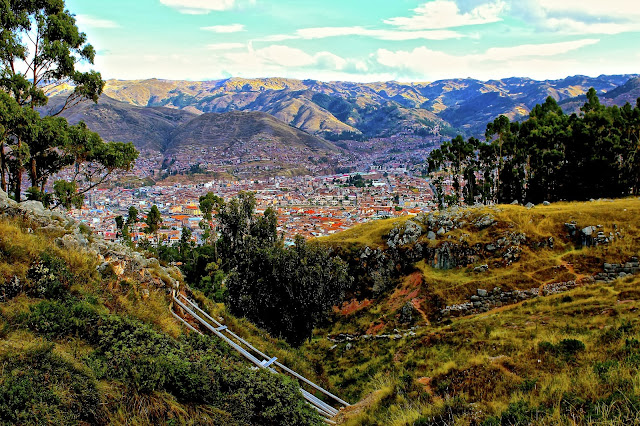Our first day in Cusco, we hit the ground running. 45 minutes of sleep into an hour-long flight, and then straight to hiking and sightseeing in the ancient Incan ruins of the now-defunct ancient city of Saqsaywaman.
The best way to describe Saqsaywaman is Peru's Stonehenge--right down to the lichen spread across the two-ton marbles blocks that were *most definitely not erected by aliens* (Psssht).
We defied the definition of "sea level" and hiked from an incredibly old palace to an even older sacrificial temple overlooking the entire provence and putting us at eye level with the rolling slopes of the Andes.
While in the valley, interspersed between the ruins and occasional European tour groups, were folded bleachers and unassembled grandstands wrapped in plastic tarps for safekeeping--waiting to be erected in honor of Inti Raymi, or "Festival of Sun," set to take place the next morning at daybreak and the official start of the summer solstice.
Perhaps the most gripping aspect of hiking through the abandoned city was the sheer magnitude of architectural and technological genius that surrounded me. For farming and anti-erosion purposes, the Incas built stone terraces into the mountainsides that functioned much like giant window box gardens. Traveling through the jungle, you would look out to the mountains and all the way up, you'd see three to ten rows of ledges, ascending like stairs into the hillside. After 600-odd years, this feat of architecture still exists--although weatherworn, it remains completely untouched.
The most amazing trait of the terraces, the city, and the temple is the precision of the stones. They're still standing after more than half a millennium, yet nothing holds it all together. The blocks of limestone and marble look almost laser-cut. They're smooth, convex shaped, and have perfectly rounded corners, and fit so closely together that you couldn't divide most of these stones with something as thin as a sheet of paper. All without mortar, chalking, or any sort of bonding agent.
The fact that some of the stones are more than ten-feet-tall and weigh upwards of two tons really affirm my disbelief in a deity. People--completely primitive by today's standards--made that structure. With their own hands and basic tools. They had to figure out on their own how to create arches and terraces, how to move, shape, and bevel stones bearing the same weight as the entire population of a small town.
All with the perseverance that people operating cranes, tractors, cars, and forklifts no longer possess.
 |
| The view from Saqsaywaman over Cusco and the Sacred Valley. |
 |
| The city ramparts. |
No comments:
Post a Comment